traction control CHEVROLET KODIAK 2007 Owners Manual
[x] Cancel search | Manufacturer: CHEVROLET, Model Year: 2007, Model line: KODIAK, Model: CHEVROLET KODIAK 2007Pages: 430, PDF Size: 6.06 MB
Page 147 of 430
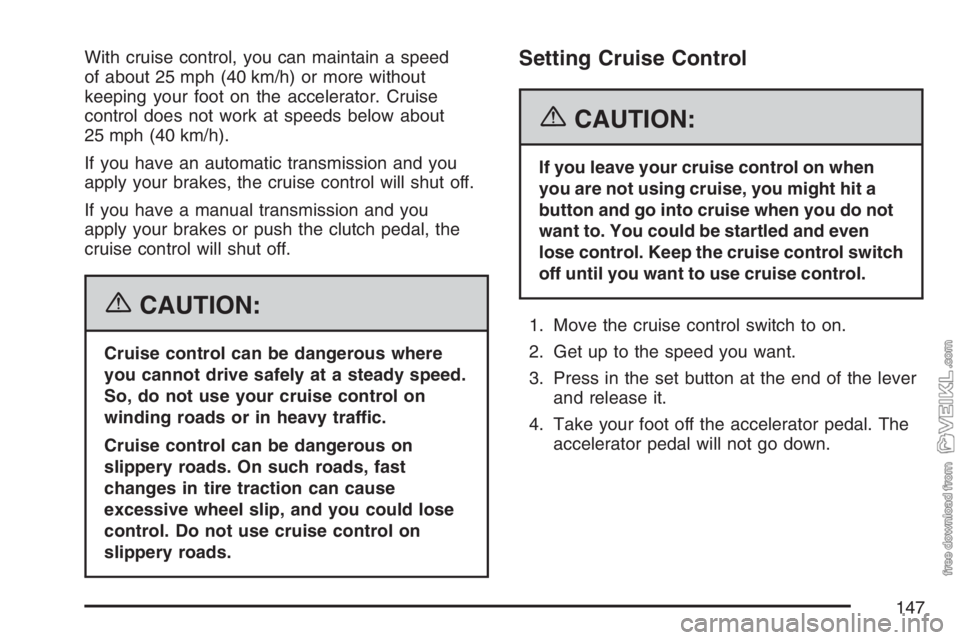
With cruise control, you can maintain a speed
of about 25 mph (40 km/h) or more without
keeping your foot on the accelerator. Cruise
control does not work at speeds below about
25 mph (40 km/h).
If you have an automatic transmission and you
apply your brakes, the cruise control will shut off.
If you have a manual transmission and you
apply your brakes or push the clutch pedal, the
cruise control will shut off.
{CAUTION:
Cruise control can be dangerous where
you cannot drive safely at a steady speed.
So, do not use your cruise control on
winding roads or in heavy traffic.
Cruise control can be dangerous on
slippery roads. On such roads, fast
changes in tire traction can cause
excessive wheel slip, and you could lose
control. Do not use cruise control on
slippery roads.
Setting Cruise Control
{CAUTION:
If you leave your cruise control on when
you are not using cruise, you might hit a
button and go into cruise when you do not
want to. You could be startled and even
lose control. Keep the cruise control switch
off until you want to use cruise control.
1. Move the cruise control switch to on.
2. Get up to the speed you want.
3. Press in the set button at the end of the lever
and release it.
4. Take your foot off the accelerator pedal. The
accelerator pedal will not go down.
147
Page 155 of 430

This switchbank is located in the center of the
instrument panel.
e(Marker Lamp Defeat Switch):SeeMarker
Lamps on page 152.
j(Manual High Idle Switch):SeeHigh Idle
System on page 106.
i(Traction Control Switch):SeeTraction
Control System (TCS) on page 216.
f(Outside Heated Mirror Switch):SeeOutside
Heated Mirrors on page 134.
g(Power Take Off Switch):SeePower
Take-Off (PTO) on page 118.
h(Rear Air Suspension Dump Control
Switch):Air Suspension on page 129.
k(Rear Axle Shift Control Switch):SeeAir Shift
Control (Automatic Transmission) on page 114.
q(Exhaust Brake Switch):SeeDiesel Engine
Exhaust Brake on page 112.
l(Differential Lock Control Switch):See
Rear Axle Differential Lock Control on page 215.
c(Airbag On/Off Switch):SeeAirbag Off
Switch on page 76.
If your vehicle does not have some of the features
controlled by these switches, there will be a
blank switch marker in its place.
155
Page 184 of 430
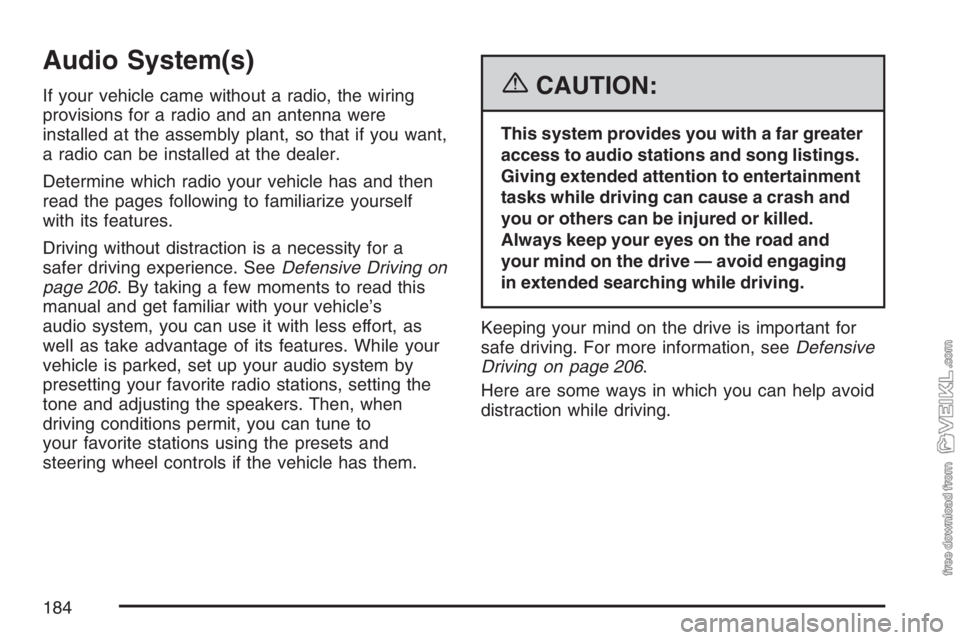
Audio System(s)
If your vehicle came without a radio, the wiring
provisions for a radio and an antenna were
installed at the assembly plant, so that if you want,
a radio can be installed at the dealer.
Determine which radio your vehicle has and then
read the pages following to familiarize yourself
with its features.
Driving without distraction is a necessity for a
safer driving experience. SeeDefensive Driving on
page 206. By taking a few moments to read this
manual and get familiar with your vehicle’s
audio system, you can use it with less effort, as
well as take advantage of its features. While your
vehicle is parked, set up your audio system by
presetting your favorite radio stations, setting the
tone and adjusting the speakers. Then, when
driving conditions permit, you can tune to
your favorite stations using the presets and
steering wheel controls if the vehicle has them.{CAUTION:
This system provides you with a far greater
access to audio stations and song listings.
Giving extended attention to entertainment
tasks while driving can cause a crash and
you or others can be injured or killed.
Always keep your eyes on the road and
your mind on the drive — avoid engaging
in extended searching while driving.
Keeping your mind on the drive is important for
safe driving. For more information, seeDefensive
Driving on page 206.
Here are some ways in which you can help avoid
distraction while driving.
184
Page 205 of 430

Your Driving, the Road, and Your Vehicle.... 206
Defensive Driving...................................... 206
Drunken Driving........................................ 207
Control of a Vehicle.................................. 210
Braking...................................................... 210
Hydraulic Brake Systems........................... 211
Anti-Lock Brake System (ABS).................. 212
Braking in Emergencies............................. 213
Trailer Brake Hand Control Valve.............. 214
Rear Axle Differential Lock Control............ 215
Traction Control System (TCS).................. 216
Steering.................................................... 217
Off-Road Recovery.................................... 219
Passing..................................................... 220
Loss of Control.......................................... 221
Driving at Night......................................... 223Driving in Rain and on Wet Roads............ 224
City Driving............................................... 227
Freeway Driving........................................ 228
Highway Hypnosis..................................... 229
Hill and Mountain Roads........................... 230
Winter Driving........................................... 231
If Your Vehicle is Stuck in Sand,
Mud, Ice, or Snow ................................. 236
Rocking Your Vehicle to Get It Out........... 236
Tow Hooks................................................ 237
Loading Your Vehicle................................ 238
Adding a Snow Plow or Similar
Equipment.............................................. 240
Towing........................................................ 241
Towing Your Vehicle ................................. 241
Trailer Connections................................... 243
Section 4 Driving Your Vehicle
205
Page 215 of 430

Rear Axle Differential Lock Control
If your vehicle has a
controlled traction or
locking differential axle,
the switch is located
in the center of
the instrument panel.
You’ll see this control on single rear axle vehicles.
If you’re approaching a slippery surface where
it looks like one or even both wheels may start
to slip, you can press the bottom of this switch.
It locks your rear differential so that power is
transmitted equally to both rear wheels.
Let up on the accelerator before you turn on your
rear axle differential lock.
Notice:Turning on the inter-axle differential
lock while the rear wheels are spinning
freely, as they might on snow or ice, can
damage the axle(s). Turn on this control only
while the wheels are not spinning freely.
Interaxle Differential Lock
This switch is located
on the center instrument
panel. You will see
this control on tandem
rear axle vehicles.
Press the switch to engage/lock the tandem front
axle differential to the rear axle differential.
This driver controlled feature improves traction
over slippery or uneven surfaces.
215
Page 216 of 430
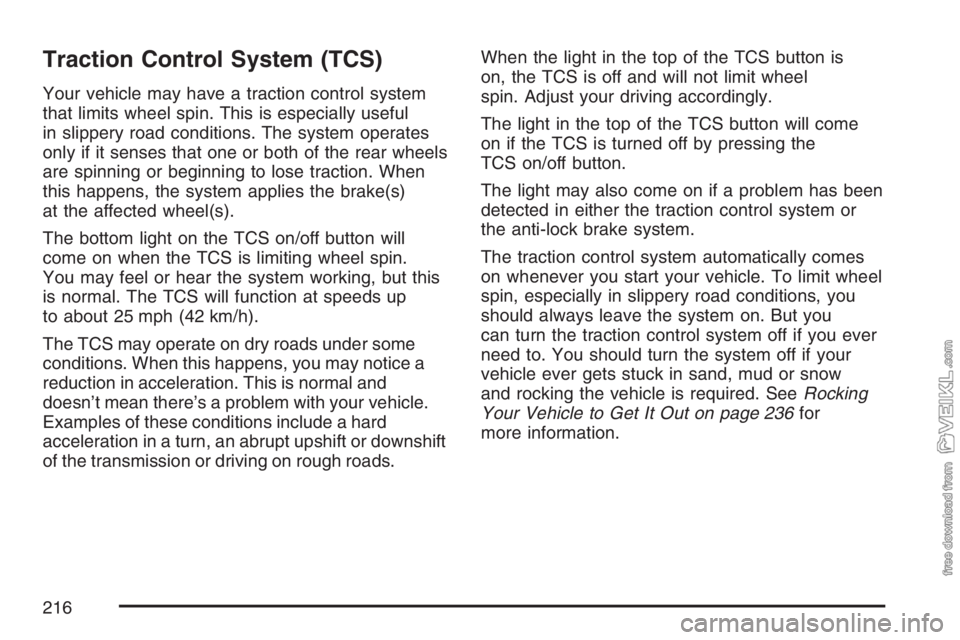
Traction Control System (TCS)
Your vehicle may have a traction control system
that limits wheel spin. This is especially useful
in slippery road conditions. The system operates
only if it senses that one or both of the rear wheels
are spinning or beginning to lose traction. When
this happens, the system applies the brake(s)
at the affected wheel(s).
The bottom light on the TCS on/off button will
come on when the TCS is limiting wheel spin.
You may feel or hear the system working, but this
is normal. The TCS will function at speeds up
to about 25 mph (42 km/h).
The TCS may operate on dry roads under some
conditions. When this happens, you may notice a
reduction in acceleration. This is normal and
doesn’t mean there’s a problem with your vehicle.
Examples of these conditions include a hard
acceleration in a turn, an abrupt upshift or downshift
of the transmission or driving on rough roads.When the light in the top of the TCS button is
on, the TCS is off and will not limit wheel
spin. Adjust your driving accordingly.
The light in the top of the TCS button will come
on if the TCS is turned off by pressing the
TCS on/off button.
The light may also come on if a problem has been
detected in either the traction control system or
the anti-lock brake system.
The traction control system automatically comes
on whenever you start your vehicle. To limit wheel
spin, especially in slippery road conditions, you
should always leave the system on. But you
can turn the traction control system off if you ever
need to. You should turn the system off if your
vehicle ever gets stuck in sand, mud or snow
and rocking the vehicle is required. SeeRocking
Your Vehicle to Get It Out on page 236for
more information.
216
Page 217 of 430
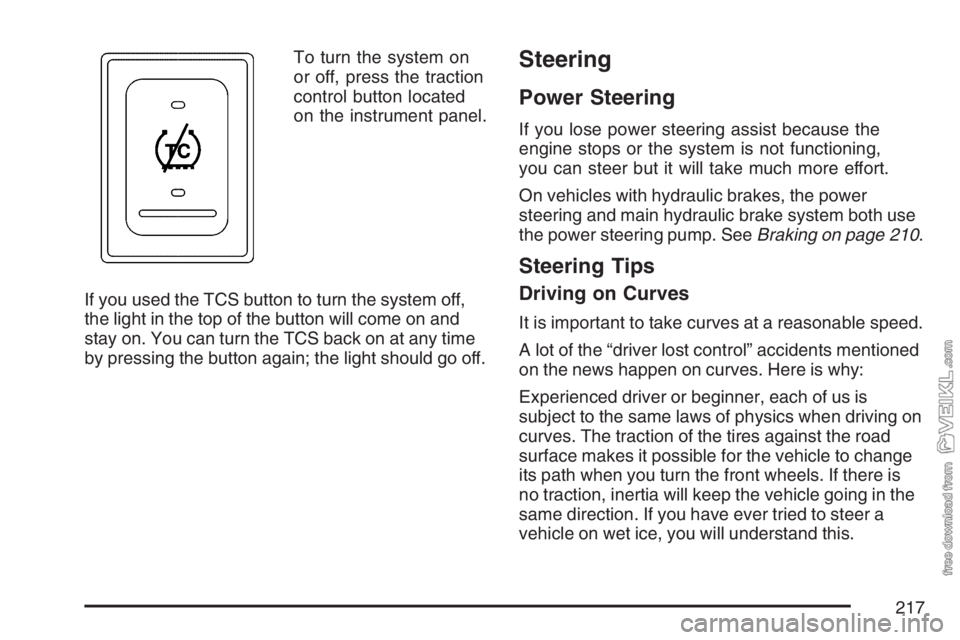
To turn the system on
or off, press the traction
control button located
on the instrument panel.
If you used the TCS button to turn the system off,
the light in the top of the button will come on and
stay on. You can turn the TCS back on at any time
by pressing the button again; the light should go off.Steering
Power Steering
If you lose power steering assist because the
engine stops or the system is not functioning,
you can steer but it will take much more effort.
On vehicles with hydraulic brakes, the power
steering and main hydraulic brake system both use
the power steering pump. SeeBraking on page 210.
Steering Tips
Driving on Curves
It is important to take curves at a reasonable speed.
A lot of the “driver lost control” accidents mentioned
on the news happen on curves. Here is why:
Experienced driver or beginner, each of us is
subject to the same laws of physics when driving on
curves. The traction of the tires against the road
surface makes it possible for the vehicle to change
its path when you turn the front wheels. If there is
no traction, inertia will keep the vehicle going in the
same direction. If you have ever tried to steer a
vehicle on wet ice, you will understand this.
217
Page 218 of 430

The traction you can get in a curve depends on
the condition of your tires and the road surface,
the angle at which the curve is banked, and
your speed. While you are in a curve, speed is
the one factor you can control.
Suppose you are steering through a sharp curve.
Then you suddenly accelerate. Both control
systems — steering and acceleration — have to
do their work where the tires meet the road.
Adding the sudden acceleration can demand too
much of those places. You can lose control.
SeeTraction Control System (TCS) on page 216.
What should you do if this ever happens? Ease
up on the accelerator pedal, steer the vehicle the
way you want it to go, and slow down.
Speed limit signs near curves warn that you should
adjust your speed. Of course, the posted speeds
are based on good weather and road conditions.
Under less favorable conditions you will want to
go slower.
If you need to reduce your speed as you approach
a curve, do it before you enter the curve, while
your front wheels are straight ahead.Try to adjust your speed so you can “drive” through
the curve. Maintain a reasonable, steady speed.
Wait to accelerate until you are out of the curve,
and then accelerate gently into the straightaway.
Steering in Emergencies
There are times when steering can be more
effective than braking. For example, you come
over a hill and find a truck stopped in your lane,
or a car suddenly pulls out from nowhere, or a child
darts out from between parked cars and stops right
in front of you. You can avoid these problems by
braking — if you can stop in time. But sometimes
you cannot; there is not room. That is the time for
evasive action — steering around the problem.
Your vehicle can perform very well in emergencies
like these. First apply your brakes.
SeeBraking on page 210. It is better to remove as
much speed as you can from a possible collision.
Then steer around the problem, to the left or
right depending on the space available.
218
Page 222 of 430
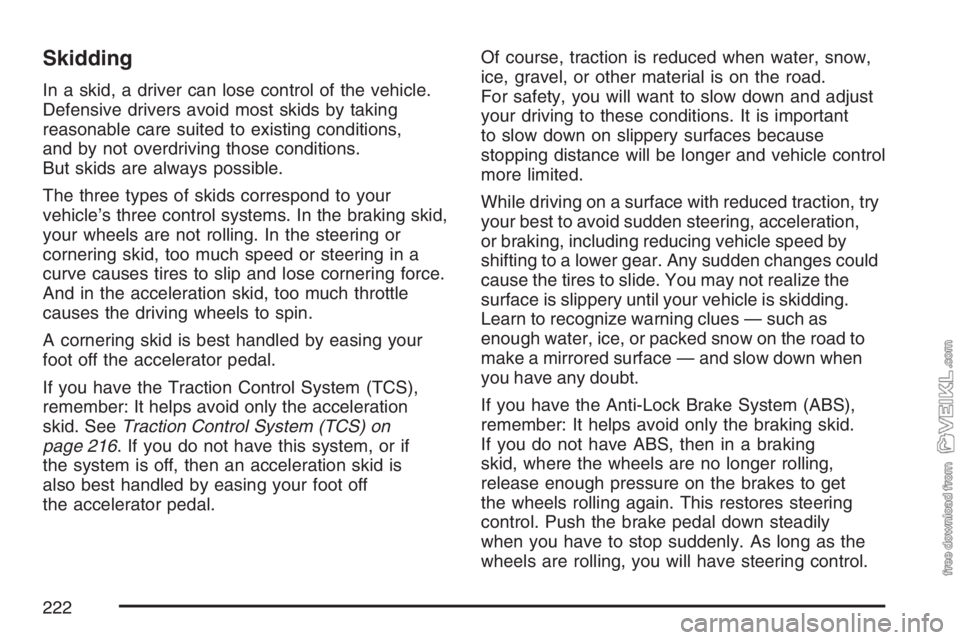
Skidding
In a skid, a driver can lose control of the vehicle.
Defensive drivers avoid most skids by taking
reasonable care suited to existing conditions,
and by not overdriving those conditions.
But skids are always possible.
The three types of skids correspond to your
vehicle’s three control systems. In the braking skid,
your wheels are not rolling. In the steering or
cornering skid, too much speed or steering in a
curve causes tires to slip and lose cornering force.
And in the acceleration skid, too much throttle
causes the driving wheels to spin.
A cornering skid is best handled by easing your
foot off the accelerator pedal.
If you have the Traction Control System (TCS),
remember: It helps avoid only the acceleration
skid. SeeTraction Control System (TCS) on
page 216. If you do not have this system, or if
the system is off, then an acceleration skid is
also best handled by easing your foot off
the accelerator pedal.Of course, traction is reduced when water, snow,
ice, gravel, or other material is on the road.
For safety, you will want to slow down and adjust
your driving to these conditions. It is important
to slow down on slippery surfaces because
stopping distance will be longer and vehicle control
more limited.
While driving on a surface with reduced traction, try
your best to avoid sudden steering, acceleration,
or braking, including reducing vehicle speed by
shifting to a lower gear. Any sudden changes could
cause the tires to slide. You may not realize the
surface is slippery until your vehicle is skidding.
Learn to recognize warning clues — such as
enough water, ice, or packed snow on the road to
make a mirrored surface — and slow down when
you have any doubt.
If you have the Anti-Lock Brake System (ABS),
remember: It helps avoid only the braking skid.
If you do not have ABS, then in a braking
skid, where the wheels are no longer rolling,
release enough pressure on the brakes to get
the wheels rolling again. This restores steering
control. Push the brake pedal down steadily
when you have to stop suddenly. As long as the
wheels are rolling, you will have steering control.
222
Page 233 of 430
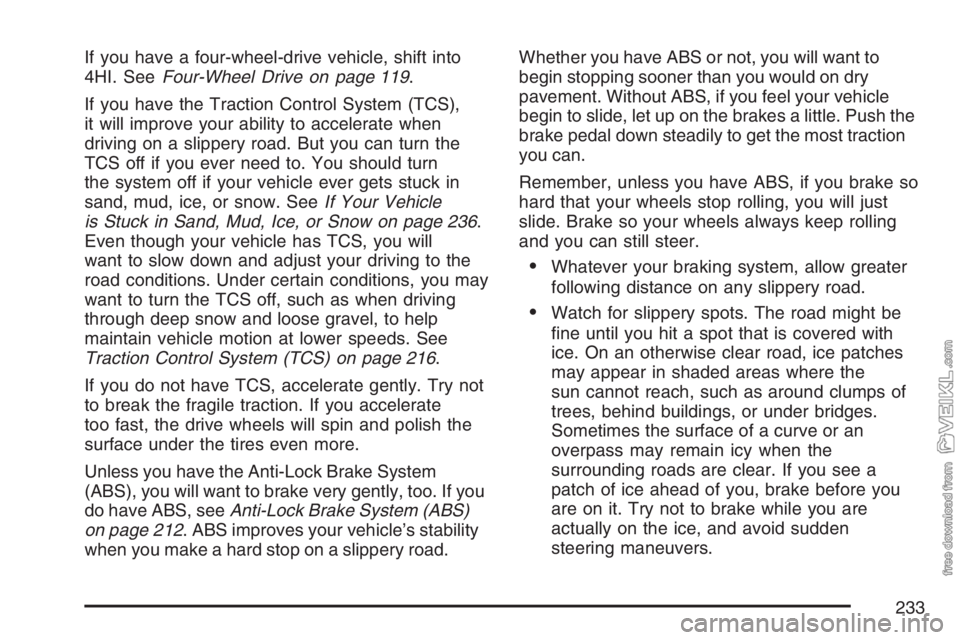
If you have a four-wheel-drive vehicle, shift into
4HI. SeeFour-Wheel Drive on page 119.
If you have the Traction Control System (TCS),
it will improve your ability to accelerate when
driving on a slippery road. But you can turn the
TCS off if you ever need to. You should turn
the system off if your vehicle ever gets stuck in
sand, mud, ice, or snow. SeeIf Your Vehicle
is Stuck in Sand, Mud, Ice, or Snow on page 236.
Even though your vehicle has TCS, you will
want to slow down and adjust your driving to the
road conditions. Under certain conditions, you may
want to turn the TCS off, such as when driving
through deep snow and loose gravel, to help
maintain vehicle motion at lower speeds. See
Traction Control System (TCS) on page 216.
If you do not have TCS, accelerate gently. Try not
to break the fragile traction. If you accelerate
too fast, the drive wheels will spin and polish the
surface under the tires even more.
Unless you have the Anti-Lock Brake System
(ABS), you will want to brake very gently, too. If you
do have ABS, seeAnti-Lock Brake System (ABS)
on page 212. ABS improves your vehicle’s stability
when you make a hard stop on a slippery road.Whether you have ABS or not, you will want to
begin stopping sooner than you would on dry
pavement. Without ABS, if you feel your vehicle
begin to slide, let up on the brakes a little. Push the
brake pedal down steadily to get the most traction
you can.
Remember, unless you have ABS, if you brake so
hard that your wheels stop rolling, you will just
slide. Brake so your wheels always keep rolling
and you can still steer.
•Whatever your braking system, allow greater
following distance on any slippery road.
•Watch for slippery spots. The road might be
fine until you hit a spot that is covered with
ice. On an otherwise clear road, ice patches
may appear in shaded areas where the
sun cannot reach, such as around clumps of
trees, behind buildings, or under bridges.
Sometimes the surface of a curve or an
overpass may remain icy when the
surrounding roads are clear. If you see a
patch of ice ahead of you, brake before you
are on it. Try not to brake while you are
actually on the ice, and avoid sudden
steering maneuvers.
233